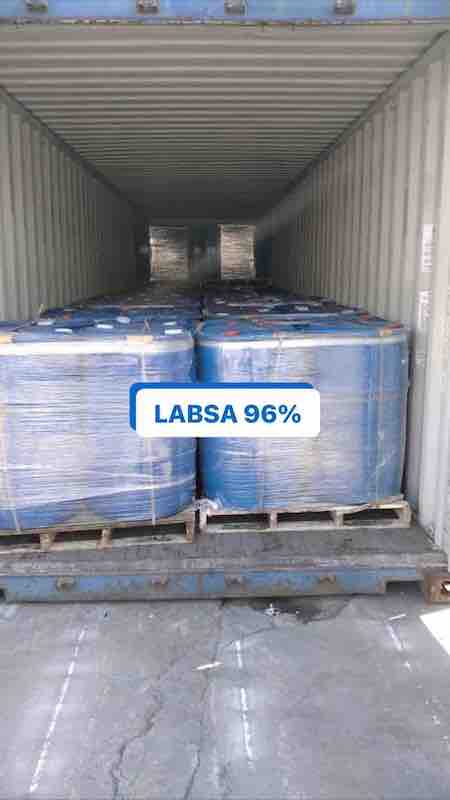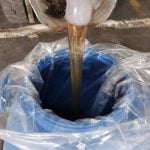
LABSA commercial name of Linear alkyl benzene sulfonic acid
- Home
- LABSA commercial name of Linear alkyl benzene sulfonic acid

What is LABSA?
Linear alkyl benzene sulfonic acid called LABSA a chemical which is colorless and have viscous properties. Sulfonic acid mainly using in detergent formulations so it is one of the most important and cheapest surfactants in powder formulation and detergent fluids.
Sulfonic acid
It is other name of LABSA which is soluble in water and emulsifying agent also Alkyl benzene sulfonic acid is one of the most widely used anionic surfactants due to its low cost, high efficiency and biocompatibility due to its linear chain.
This anionic surfactant has hydrophilic and hydrophobic groups. These are non-volatile compounds produced by the sulfonation process. These compounds consist of mixtures of carbon chains of 10 to 14 carbon lengths that are a phenyl group with a sulfonate group.
Table of Contents
ToggleLABSA price
On March 2 2025 price of LABSA in the Middle east was beyween 1050USD/MT to 1450USD/MTdepend on origin.
Difference Between Sulfonic Acid (C₁₂H₂₅C₆H₄SO₃H) and Sulfuric Acid (H₂SO₄)
- LABSA is an organic acid (contains benzene and alkyl chain).
- Sulfuric Acid (H₂SO₄) is an inorganic acid (does not contain carbon chains).
- LABSA is used as a surfactant in detergents, whereas H₂SO₄ is a strong mineral acid used in chemical manufacturing.
LABSA usage
1. Detergent Industry
- LABSA is a key ingredient in the production of household and industrial detergents.
- Used in laundry powders, liquid detergents, and dishwashing liquids due to its excellent cleaning and foaming properties.
- Commonly found in toilet cleaners and multi-purpose cleaners.
2. Industrial Cleaning Agents
- Used in degreasers for removing grease and oil in factories, workshops, and industries.
- Found in car wash shampoos and floor cleaning agents.
3. Textile Industry
- Used as a wetting and emulsifying agent in the textile processing industry.
- Helps in dyeing and bleaching processes.
4. Leather Industry
- Used as a penetrating and dispersing agent in leather processing.
- Helps in removing grease and impurities from hides and skins.
5. Agricultural Chemicals
- Used as an emulsifier in pesticide formulations to enhance effectiveness.
6. Oilfield Chemicals
- Used in oil recovery processes and drilling fluids to improve the efficiency of oil extraction.
7. Paper Industry
- Helps in paper de-inking and processing.
Advantages of LABSA
- High detergent and cleaning power.
- Excellent solubility in water.
- Biodegradable and environmentally friendly compared to older surfactants.
Would you like information on LABSA suppliers or technical specifications?
Packing of sulfonic acid LABSA
item | Packing | Quantity/FCL | N.W/FCL | G.W/FCL |
LABSA | 210 Kgs/plastic Drum | 80 Drums | 16.80 MT | 17.600 MT |
215 Kgs/plastic Drum | 80 Drums | 17.20 MT | 18.000 MT | |
1000 Kgs/IBC | 18 IBC s | 18.00 MT | 19.152 MT |
- LABSA package by 200 kg
- Linear Alkyl Benzene package by 210 kg
- Sulfonic Acid package by 220 kg net plastic drum. It’s possible packing in pelleting for each 4 LABSA drums. However according to customer inquiries it is able to offer in Bulk.
Handling and Storage
- Store in a cool, dry, and well-ventilated area.
- Use corrosion-resistant containers (preferably plastic or stainless steel).
- Avoid contact with strong oxidizing agents (e.g., nitric acid, peroxides).
- Keep away from heat and direct sunlight to prevent degradation.
LABSA specification
Sulfonic acid is a class of organic acids that have a general formula of R-SO3H, where R is an organic group. Sulfonic acids are strong acids and have a wide range of industrial and laboratory applications, including as catalysts, detergents, and ion-exchange resins. Below is a data sheet for sulfonic acid:
- Chemical formula: R-SO3H Molecular
- weight: varies depending on the organic group attached to the sulfonic acid Appearance: varies depending on the form of sulfonic acid, can be a colorless liquid or a solid
- Odor: odorless or has a faint sulfurous odor
- Melting point: varies depending on the form of sulfonic acid, can range from -25°C to 1000°C
- Boiling point: varies depending on the form of sulfonic acid, can range from 20°C to over 300°C
- Solubility: highly soluble in water and polar solvents, but insoluble in nonpolar solvents
- Density: varies depending on the form of sulfonic acid, can range from 1.2 g/cm3 to over 2.0 g/cm3
- pKa: typically between -1 and 3, indicating strong acidity
- Reactivity: sulfonic acids are strong acids and can react with strong bases, metals, and oxidizing agents
- Hazards: sulfonic acids can cause skin and eye irritation and are corrosive to metals, and should be handled with care in a well-ventilated area using appropriate personal protective equipment.
- Note: The specific properties of sulfonic acid can vary depending on the specific organic group attached to the sulfonic acid.
Active ingredients | 90% (Min.) |
Free Sulphuric Acid | 4-7% (Max) |
Free Oil | 1% (Max) |
Color Klett | 35 When packed (Max) |
Density (gm/ml at 200c) | 1.07 |
Appearance | Light Yellow-Brown Liquid |
Viscosity | Low Viscosity |
Mean Molecular Mass | Average 326
|
Download PDF
LABSA Linear alkyl benzene sulfonic acid
Contact Info
Turkey office:No.6 of Fahrettin Pasa Sokak , Galip Erdem steet, Ilkbahar Mah. Turan Gunes Ave. Çankaya Ankara
Phone: 00903125147055
Dubai office: 3509 of the Burligton tower, business bay, dubai-uae
Phone:0097142369830
E-Mail: [email protected]

